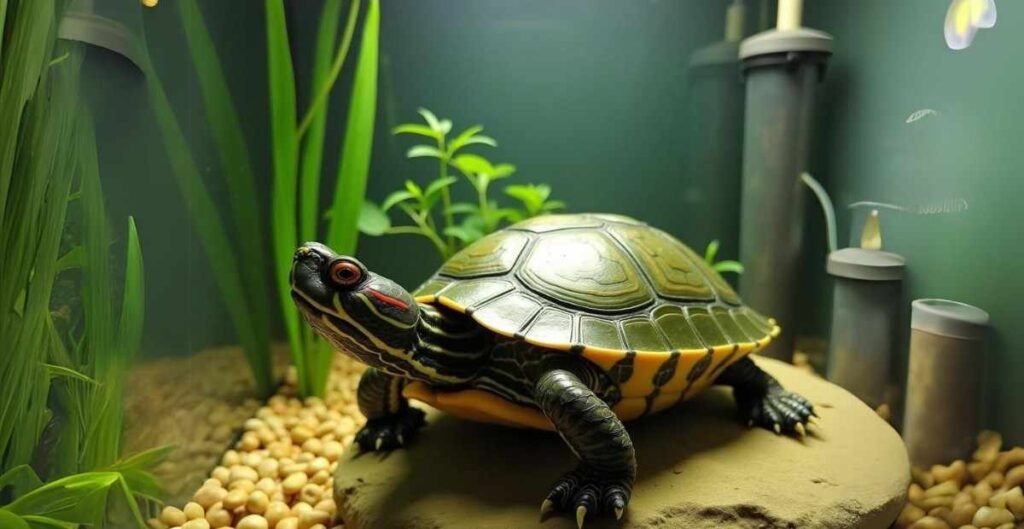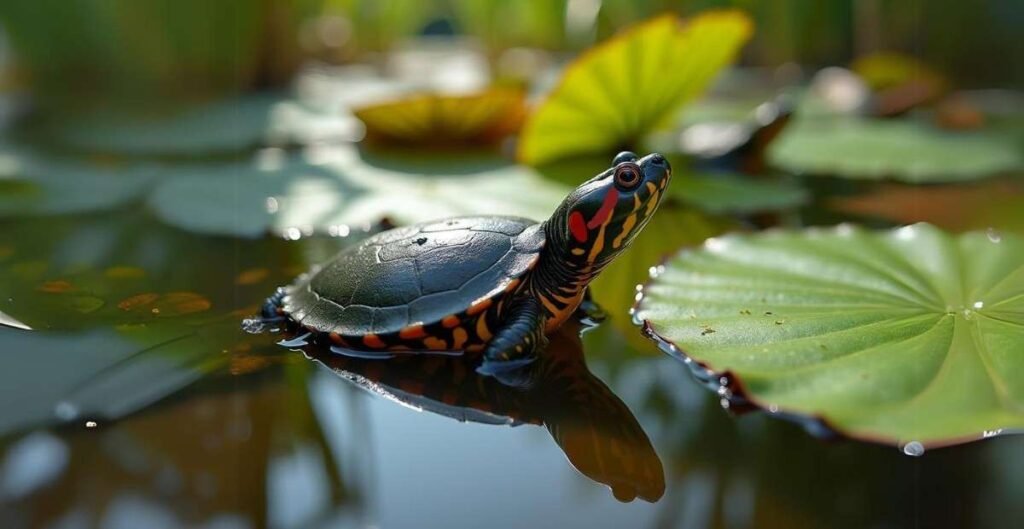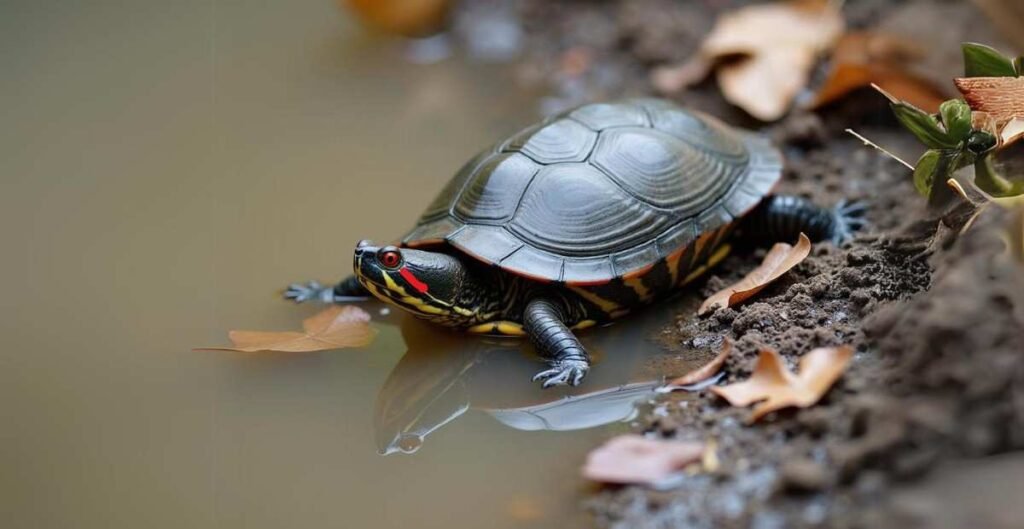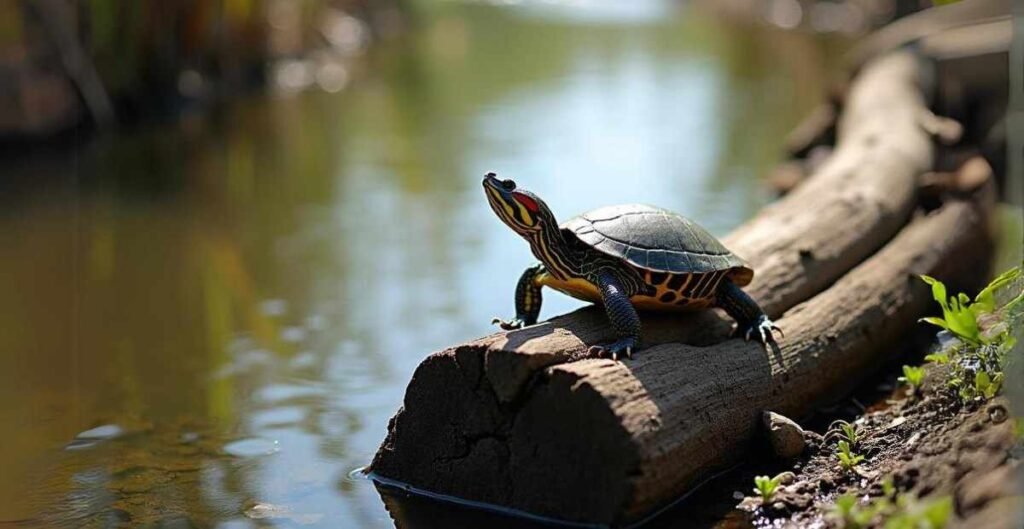If you are a wildlife enthusiast, you may have heard about the word “Hibernate or Hibernation”. There are some animals, including reptiles, birds, and butterflies, that go into a hibernation state. Red-eared sliders are one of the loved and familiar turtle species that people are taking as pets. As we are talking about hibernation and if you own a red eared slider, you may have this question “Do red eared sliders hibernate”?
A lot of animals go into hibernation during the winter, but red-eared sliders do something different. They brumate. Burmation is a type of sleep that helps these turtles survive the colder months without completely shutting down. So, in today’s post, we will be diving into this question “do red eared sliders hibernate”?
Do Red Eared Sliders Hibernate?

No, red-eared sliders do not hibernate. Instead, they enter into a state called brumation, which is like hibernation but not as heavy. Unlike hibernation, when they sleep deeply and for long periods of time, when they brumate, their metabolic activity drops a lot. This lets them save energy while still being somewhat active. Hibernation is a state where some animals slow down their physical activity, and go into a lazy or sleeping state during winter.
Comparison Between Brumation vs. Hibernation
Many animals get used to the colder weather by going into dormancy as winter comes, but these changes are not all the same. Red-eared sliders go through a different stage of sleep than animals like bears do during hibernation. This stage is called brumation. Hibernation is a deep, long sleep. Brumation is a lighter form of dormancy in which these lizards slow down but stay mostly active. They only wake up to drink water on warmer days to stay hydrated.
Red-Eared Sliders Adaption For Brumation
Red-eared sliders are cold-blooded. They have learned to naturally slow down their bodies when the temperature drops. In order to save energy during the cold months, this change is very important. In contrast to mammals, cold-blooded animals like red eared sliders stay mostly inactive during the brumation period, which often lasts for three months. This is because it fits with their natural rhythms and keeps them healthy and balanced.
Importance of Brumation
Red-eared sliders need to burrow to stay alive, but it’s also important for their general health and is a key part of how well they can reproduce. If you want to breed red sliders, you need to let them brumate so they are ready for breeding season which happens from March to July.
Brumation in the Wild vs. Captivity
When it gets below 50°F (10°C) in the wild, red-eared sliders start to hibernate in October. They hide in muddy ponds or other secluded places. This slows down their metabolism and heart rate. If kept warm, trapped sliders might not need to brumate, but they might still try to do so if the environment is cooler.
Brumation vs. Estivation
There is another form, which is Estivation, like brumation. During estivation, animals go into slower activity or dormancy during extremely hot or dry seasons to conserve their energy. While during brumation animals slower their metabolism during winter. Red-eared sliders generally do not estivate, so owners do not need to worry about this form of dormancy.
Unique Underwater Respiration
Red-eared sliders have a unique adaptation that they use during brumation: they breathe underwater. Using cloacal respiration, they can stay underwater for long periods of time by absorbing oxygen through blood vessels in their cloaca. This helps them live in low-oxygen environments.
Natural Hibernation Behaviors of Eared Slider?

In the wild, how do red eared sliders hibernate? Let’s see their natural habitat behavior –
Where Red-Eared Sliders Live?
They survive well in watery places like lakes, ponds, swamps, and marshes. Red eared turtles like places where the water moves slowly, the bottom is soft, and there are lots of plants in the water. Also, they need places to rest, usually on logs or rocks, called basking spots.
Cold Month Behaviors
As it gets colder, red-eared sliders go into a sleepy state called brumation. In this state, they’re not really asleep, but they move much more slowly. You may notice that they are less busy and only wake up to drink sometimes. In ponds and lakes where the water is steady, they often settle at the bottom. In times when food is short, this helps them save energy.
Environmental Cues for Brumation
To get ready for captive outdoor brumation, ensure your pond is deep enough to prevent freezing—aim for at least 6 inches of water. You should consider providing shelters like logs or rocks, and protect the area from predators. Use filtration systems to prevent contamination and illness by monitoring and ensuring top-notch water quality.
How To Prepare for Brumation Indoors For Red-eared Sliders?

Let’s see how to prepare red eared slider habitat before brumation for both indoors and outdoors.
Indoor Preparation
You have to create a controlled environment if you want red-eared sliders to brumate indoors. You can begin by putting your turtle in a well-ventilated box filled with damp soil and leaf litter. Store this box in a mini-fridge maintained at a temperature of 37-41°F (3-5°C). This temperature range allows them to safely reduce their metabolism. You should check on your turtle frequently, and you should soak it in shallow water every few weeks to keep it hydrated.
Temperature and Humidity Management
Maintaining stable temperatures is crucial. For red-eared sliders, a temperature below 35°F (2°C) can be harmful and can cause freezing. On the other hand, above 60°F (15°C) can trigger false brumation. During this try to monitor your turtle’s weight as they take less food and adjust conditions as needed. If you get your red-eared turtle’s weight loss exceeding 1%, consult a vet immediately.
How To Set Outdoor Preparation For Red Eared Sliders?
If you plan to set up captive outdoor brumation, make sure your pond’s deep enough to prevent freezing. Make sure they have shelter, like logs or rocks, and protect them from predators. Be sure to keep your water clean by checking it regularly and filtering it.
Put up barriers to keep animals out of the outside environment. Your turtle’s safety when it brumates can be enhanced with this protection. Be sure to check for any indications of predators or security breaches on a regular basis.
No matter if you’re keeping your red-eared slider indoors or out, a safe and a safe brumation environment is possible with some careful planning.
What Are The Signs of Brumation For Red Eared Sliders?

There are some signs before brumation, you should know about these to take care of things beforehand –
Identifying Brumation Readiness
Red-eared sliders show unique signs when they are prepared to brumate. If you notice any decrease in activity it means they have less energy. It’s usually around October that their appetite drops.
Behavioral Changes
Your red-eared turtle might take more time to relax. They may not eat a lot, meaning their body’s readiness for the upcoming colder months. If the red-eared slide is showing natural changes that suggests it is preparing for brumation.
Importance of Monitoring Health
Make sure your turtle is in good health before brumation starts. Take your pet to the veterinarian for a check-up, paying special attention to their weight and general health. Turtles that are well-nourished are more likely to have a safe brumation.
Weight Monitoring
Weigh your turtle consistently to monitor any fluctuations. Notable weight loss, as we mentioned above exceeding 1%, may suggest underlying health problems. If this occurs, seek the advice of a veterinarian right away. Keeping track of your turtle’s weight helps you stay informed about its health condition.
How To Take Care Of Red-Eared Sliders During and After Hibernation?
If you have any red eared sliders, you should be aware of how you can take care of them during or after the hibernation period. Let’s see how you should do it –
During Brumation
Taking care of red-eared sliders while they are in brumation is essential. Routine health assessments are essential to keep track of their well-being. Keep the environment at a temperature between 37-41°F (3-5°C) to support a consistent metabolic rate. Make sure to check on your turtle each week and weigh them every 2 to 4 weeks to monitor any changes. While performing these checks, for a certain time, keep them in shallow water, as they are semiaquatic, to ensure they are properly hydrated.
Environmental Monitoring
Watch closely the levels of temperature and humidity of your red-eared slider environment. Verify the conditions are within reasonable ranges and consistent. This steadiness keeps health problems away during brumation. For accuracy use a digital thermometer and hygrometer.
Post-Hibernation Care
Once your turtle has emerged from brumation, you should ease it back into its regular habits. Return them to their basking place as the temperature gradually rises. Serve their regular diet once you’ve given them small servings. Because of this, their digestive system can adapt more easily.
Watching for Health Issues
After brumation ends, keep a watchful eye on your turtle. Inspect the patient for any indications of unusual conduct or respiratory illnesses. See a veterinarian right away if you observe anything out of the ordinary. Your turtle will make a smooth recovery if you keep an eye on it often.
FAQs
Do red-eared sliders brumate in captivity?
Red-eared sliders may not need to brumate in captivity. If they are provided warm and steady environment. However, if temperatures fall, they might naturally try to brumate. Stable conditions with enough temperature are absolutely vital to avoid inadvertent brumation.
How long do red-eared sliders hibernate?
Usually, red-eared sliders brumate for 10 to 14 weeks. Their health and surroundings affect this length of time. Before going into brumation, their health must be closely monitored and their fat stores must be sufficient.
What to do if a red-eared slider doesn’t want to brumate?
If your slider seems reluctant to brumate, investigate the temperature and illumination of its habitat. Check their warmth and illumination. There is no problem if red red-eared slider doesn’t want to brumate. These turtles only brumate when their surrounding gets too cold, and they don’t get energy as cold-blooded reptiles. They will not brumate if they get enough warm temperature.
What do red-eared sliders do in the winter?
Red-eared sliders go into a brumation stage in winter. In the wild, they lie at the bottom of ponds and become less active. Sometimes ascending for air and water, they lower their metabolic rate to preserve energy. In warmer areas, they may bask sometimes.
How big does a red slider turtle get?
Red-eared sliders can grow up to 12 inches long. Females are often larger than males, who remain slightly smaller. As they mature, a large tank is crucial to guarantee they have enough area to swim comfortably.
The Bottom Line
So, the common question is, “Do red-eared sliders hibernate?” The answer is the brumate, do not hibernate, and these terms are quite close. Red eared slider turtles go into a condition of brumation, whereby their metabolism slows down to help them survive the colder months rather than full hibernation. Whether in captivity or the outdoors, proper care is making sure their surroundings are stable. Red-eared sliders can flourish through winter, ready to bask and explore as the temps climb, with careful attention and knowledge of their brumation requirements.
